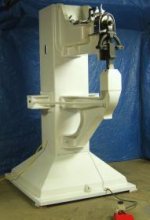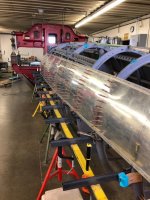leop
Plastic
- Joined
- Mar 11, 2013
- Location
- Los Gatos CA USA
I have been learning metal shaping for the last year or so. Nearly all my work has been done using a sandbag and hammers. Sometimes, if I feel very patient, I migh try and do some work using my Harbor Freight Tools beginner set of crappy metal shaping tools.
At this point in my education I don't really need more equipment except for one problem. My right arm is starting to hurt in a way that my doctor says will only get better when I stop hammering on things. So now I guess I'm in the market for a power hammer long before I have the skill to use one. But what the heck, I would rather die broke than with only one arm.
Now I thought I knew what a power hammer was, but after some research I am as confused as ever. Heck,I don't even know if I am posting in the appropriate forum!
What I have found is that almost every machine that pounds metal is called a power hammer, and yet they all seem very different to me in both how they function and the type of metal worker who uses them.
So far I have seen them called:
I also see them lumped into group based on who uses them:
Good enough you would think except all these different types of craftsmen seem to significantly cross over in terms of what kind of machine they use.
Then there are how the machineS “look” and apear to operate. There appear to be:
On some of the above machines you can tell their rough principle of operation if they expose that, but many do not. Nevertheless I understand them to fit into roughly the following groups of theory of operation.
Even among all those choices are there are: little ones, medium sized ones, huge ones, and gigantic ones.
The one and only thing they all seem to have in common is that they range in price from outrageous to astronomical.
Now all I want to do is shape some metal for God sakes. Do some light art, a car hood scoop or two, a few things for my locomotive, maybe a custom fender some long day off in the future when I get better at this art form.
Ohh and one more thing, due to their price (both the machine AND THE TRULY KILLING COST OF THE DIES) I need to build whatever I pick. I'm not too worried about this part because I have a cnc mill, cnc lathe, conventional lathe and mill, the reluctant to use financial means to have things laser or waterjet cut, and a 4x8 cnc plasma cutter I can borrow.
I just need to know what the heck to build, keeping in mind that the simpler the machine the better because my hobby is sheet metal work, not building power hammers.
So what the heck givers with all this power hammer schizophrenia?
Ohh, and I know of the smallest nibler Pettingell built for sale for $700, and it needs a full rebuild. Should I get that before somone wanting to be the next super rich motorcycle builder grabs it?
Sorry for the long post.
At this point in my education I don't really need more equipment except for one problem. My right arm is starting to hurt in a way that my doctor says will only get better when I stop hammering on things. So now I guess I'm in the market for a power hammer long before I have the skill to use one. But what the heck, I would rather die broke than with only one arm.
Now I thought I knew what a power hammer was, but after some research I am as confused as ever. Heck,I don't even know if I am posting in the appropriate forum!
What I have found is that almost every machine that pounds metal is called a power hammer, and yet they all seem very different to me in both how they function and the type of metal worker who uses them.
So far I have seen them called:
- Reciprocating Hammer Machine
- Nibbler Machine, that I have never seen used to actually nibble metal.
- Power Hammer
- Drop Hammer
- Mechanical Forging Hammer
- Open Die Power Forging Hammer
- And for light work possible use of a planishing hammer - which I already own a crappy version of.
I also see them lumped into group based on who uses them:
- Generic metal formers, whatever that means
- Hot rod builders
- Blacksmiths
- Sheet metal men
- Coach builders
- Artists
Good enough you would think except all these different types of craftsmen seem to significantly cross over in terms of what kind of machine they use.
Then there are how the machineS “look” and apear to operate. There appear to be:
- Little Giant types of machines.
- Junk hammers which resemble Little hammer machines
- Pullmax, Eckold power hammers, Yoder, Thrumpf, etc. type machines.
On some of the above machines you can tell their rough principle of operation if they expose that, but many do not. Nevertheless I understand them to fit into roughly the following groups of theory of operation.
- Hydraulic
- Pneumatic with external compressor,pneumatic with compressor built in
- Mechanical reciprocating through the full up down cycle
- Mechanical with mechanical retract only(of Hydraulic, Pneumatic), and downward force provided by gravity.
Even among all those choices are there are: little ones, medium sized ones, huge ones, and gigantic ones.
The one and only thing they all seem to have in common is that they range in price from outrageous to astronomical.
Now all I want to do is shape some metal for God sakes. Do some light art, a car hood scoop or two, a few things for my locomotive, maybe a custom fender some long day off in the future when I get better at this art form.
Ohh and one more thing, due to their price (both the machine AND THE TRULY KILLING COST OF THE DIES) I need to build whatever I pick. I'm not too worried about this part because I have a cnc mill, cnc lathe, conventional lathe and mill, the reluctant to use financial means to have things laser or waterjet cut, and a 4x8 cnc plasma cutter I can borrow.
I just need to know what the heck to build, keeping in mind that the simpler the machine the better because my hobby is sheet metal work, not building power hammers.
So what the heck givers with all this power hammer schizophrenia?
Ohh, and I know of the smallest nibler Pettingell built for sale for $700, and it needs a full rebuild. Should I get that before somone wanting to be the next super rich motorcycle builder grabs it?
Sorry for the long post.





 Been doing it since 2004
Been doing it since 2004